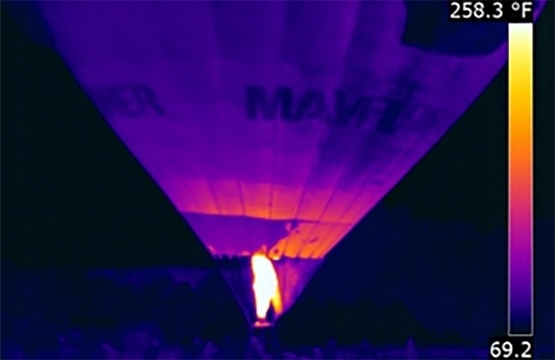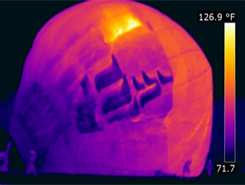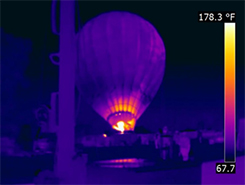

Often in our classes, we are asked “what are the most interesting thermal images that you’ve taken?” I always think back to a time that I was asked to look at a hot air balloon by the pilot of the Mayflower balloon.
It was a great afternoon during Canton, Ohio’s “Hall of Fame” week, and every year there is a balloon festival. I thought, “This year I’ll bring my infrared camera and try to get some good images.” At one point the pilot of the Mayflower balloon walked by and saw my thermal imager and it piqued his interest.
After a quick, condensed discussion of some thermodynamic topics, he was hooked. I asked him, “Do you think heat rises?” I could see in the pilot’s eyes that he started to “Think Thermally®”! He answered correctly… “No”.
Many people answer that question incorrectly due to not thinking it through, or hearing that heat rises at some point in school. Heat is energy and it will typically flow from warmer to cooler. However, when air is heated it becomes less dense, making the warmer air molecules rise while the cooler air molecules sink down. The balloon's propane fuel, once lit, is used to heat the air which then rises and becomes trapped inside the balloon. Air, because of its low thermal capacitance, can be heated pretty quickly and once the air inside becomes less dense (weighs less) than the air on the outside of the balloon, lift is achieved.
The pilot had some great questions about heat transfer and the effects of the heat on the materials of the balloon. He was starting to think about the baffles around the middle of the balloon. The baffles are how a pilot can control how much air is being released, which controls the altitude.
The pilot was curious to see if any flaws in the material would show up on an IR camera. The images taken are showing the balloon as it is getting ready for flight. The first image is showing one of the baffles that wasn’t working correctly. At first, the pilot had a hard time getting the balloon to, fill and rise up. After the pilot saw the image, he spoke to the ground crew, and they found one of the baffle lines had a small knot that was hanging up keeping the baffle open.

After the knot was fixed, the balloon lifted at a nice pace. The pilot told me that a balloon must be filled correctly and as evenly as possible. He said that a balloon’s fuel is for flying, so they want to minimize the fuel in getting it filled up.

It was amazing to see how much quicker the balloon lifted after the knotted line was fixed. The pilot seemed happy to run into a thermographer that evening. The pilot said the day before, he was thinking of scrubbing the airshow. He tried multiple times earlier in the week to get a good lift but was unsuccessful as it took too much fuel to fill the balloon properly.
I learned so much about balloons that day. Putting a little thermal thinking to use helped that pilot too. We stayed in touch after that. The pilot owns an infrared camera now and it is part of the Mayflower balloon program. I get a warm feeling now every time I see a hot air balloon.